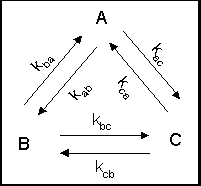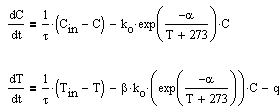Assignment 5
CM5100
Due November 13, 2003
(For the following problems, you will need the differential equation
solver. Please click here
to access a short tutorial on how to use ode45.)
1. Wei-Prater Kinetics.
Using the data given in the following links:
www.chem.mtu.edu/~tbco/cm5100/wpdata1.dat
www.chem.mtu.edu/~tbco/cm5100/wpdata2.dat
www.chem.mtu.edu/~tbco/cm5100/wpdata3.dat
www.chem.mtu.edu/~tbco/cm5100/wpdata4.dat
(You can also download the m-functions I wrote that could help you
plot the ternary diagrams:
draw_ternary.m
plot_ternary.m
getPoints_ternary.m
plus the short
tutorial on what these commands do. )
Determine the rate constants for the process shown in Figure 1 where
the reactions are all first order kinetics.

Figure 1. Three Simultaneous Reversible Reactions for Wei-Prater Data.
2. Stiff Differential Equations.
Suppose you have the for the differential equation: dx/dt = Ax, where
the matrix A is given by,
>> A=1e4*[-1.0002, 0.0002, -0.9998;
-1.0003, 0.0003,-0.9997;
0.0002, -0.0002, -0.0002];
-
Try using ode45 as before, simulating from 0 to 100. What happens ?
-
Now try using ode15s instead. What happens ? Plot the results
-
Check the eigenvalues of A and discuss the range of eigenvalues.
Note: Varying the order of magnitudes in eigenvalues is just one
instance where equations are "stiff", there are known cases where the eigenvalues
are not far apart and yet the normal RK methods do not perform well. There
are other methods also available in Matlab to solve stiff problems (you
can use the help files to learn more.)
3. Linear Boundary Value Problems .
For linear boundary value problems given by

Method 1: using superposition.
Let v be the solution obtained using solvers such as ode45 with initial
conditions, v(0)=1 (which is y(0)), and dy/dt(0)=any.
>> [t1,v] = ode45(@diffeqn, [0:0.1:3], [1
;1]);
Notes:
-
You need to supply/create the m-file for the differential equations such
as diffeqn.m that describes your system
-
Explicitly state the intervals in the range of your independent values:
[0:0.1:3]
-
For v, we are using the same initial value, y(0) but choosing the dv/dt(0)
=1.
Let w be the solution with initial conditons, w(0)=0, dw/dt=any.
>> [t2,w] = ode45(@diffeqn, [0:0.1:3], [0
;1]);
Notes:
-
We use the same explicitly stated the intervals in the range of independent
values: [0:0.1:3]
-
For w, we are using the null initial value, w(0)=0 but choosing the dw/dt(0)
=1.
Now, solve for a such that the superposition
of v and w will yield the required second boundary condition at t=3, i.e.
we want: y(t) = v(t) + a w(t), this means,
a = [ y(t=3) - v(t=3) ]/ w(t=3)
Finally, combine to obtain the required y.
y = v + a w
Plot y as a function of t and see if it satisfies the boundary conditions.
( There are several other methods for solving boundary value problems,
ranging from shooting methods to finite element methods. Matlab has the
command bvp4c to handle
not only linear, but several nonlinear, boundary value problems. See help
files to explore these functions.)
4. Qualitative Analysis
The following equations describe the dynamics equations of a CSTR:

Suppose the parameters of the process are given by the following values:
|
t
|
120
|
|
Cin
|
0.9
|
|
a
|
2000
|
|
ko
|
0.1
|
|
b
|
-1550
|
|
q
|
0.2
|
|
Tin
|
40
|
a) Obtain the equilibrium points of the given process. (Hint: first
set dC/dt=f(C,T)=0
to find C in terms of T, i.e. C=h(T). then substitute
this function into dT/dt=0=f(C,T)
to solve for T.)
b) At each of the equilibrium points, predict the behavior of the phase
space
in the neighborhood of these points, i.e. will it
be a stable node, unstable
node, saddle, unstable focus or stable focus.
c) Simulate the process at various initial conditions. For instance,
using matlab, you could use the following commands:
for i = 0.6:0.1:1
[t,x]=ode45(@cstr,[0
1000],[i 20]);
plot(x(:,1),x(:,2));
hold on
end
for i = 20:10:200
[t,x]=ode45(@cstr,[0
1000],[0.6 i]);
plot(x(:,1),x(:,2));
hold on
end
for i = 20:10:200
[t,x]=ode45(@cstr,[0
1000],[1 i]);
plot(x(:,1),x(:,2));
hold on
end
axis([0.6 1 0 400])
where the model for the process is given in the file cstr.m
given
by:
function dx=cstr(t,x)
ko=0.1;
tau=120;
Cin=0.9;
alpha=2000;
beta=-1550;
q=0.2;
Tin=40;
C=x(1);
T=x(2);
rate = ko*exp(-alpha/(T+273))*C;
dC=(Cin -
C)/tau - rate;
dT=(Tin -
T)/tau -rate*beta-q;
dx=[dC;dT];


